|
|

|
|
|
|
Horseback riding vacations in
Portugal
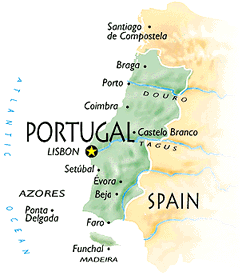 Portugal is a country of astonishing diversity, idyllic weather, welcoming people and exceptional horse riding. Hidden Trails’ Portuguese horse riding holidays include coastal rides on deserted beaches, trails along rolling hillsides, and classical dressage clinics. Portugal contains enough World Heritage Sites, picture postcard scenery and windswept coastlines to keep any visitor busy – especially on a world-class horse riding vacation! Portugal is a country of astonishing diversity, idyllic weather, welcoming people and exceptional horse riding. Hidden Trails’ Portuguese horse riding holidays include coastal rides on deserted beaches, trails along rolling hillsides, and classical dressage clinics. Portugal contains enough World Heritage Sites, picture postcard scenery and windswept coastlines to keep any visitor busy – especially on a world-class horse riding vacation!
Horse Riding in Portugal
Portugal is a land of infinite options from mingling with the crowds in one of the more sophisticated beach resorts to wandering through the medieval quarters of historic cities like Lisbon, Porto, Braga or Coimbra. To explore the more remote beauty spots, stay overnight in a romantic pousada - a converted farm, monastery or manor house enjoying a wonderful setting. Many of our horseback vacations in Portugal offer the chance to enjoy similar accommodations.
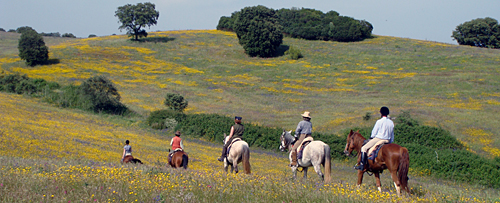
Our Alentjo (Blue Coast) horse riding holidays are located on the stunning southwest coast of Portugal. Here you can ride along the isolated and stunning Blue Coast, or combine your love of horse riding with dolphin encounters on the Dolphin Coast rides.
Riders wishing to embark on a classical dressage clinic can try our Lusitano Riding Centre Alcainca Program. This world-class facility offers dressage training with renowned riding instructors, on beautiful Lusitano horses for an educational horseback vacation.
Northern Portugal is another great destination for horseback riding holidays. You can explore the beautiful Peneda Geres National Park and hopefully spot a herd of the resident wild horses.
We also offer several riding packages in the Azores. Our Faial Island Trail lets you tour this beautiful island while staying in the same comfortable lodge every night. On the island of Sao Miguel, we offer two different center-based rides in a lovely Quinta near Ponta Delgada.
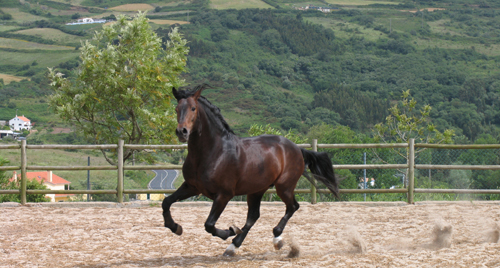
The Lusitano Horse
The Lusitano horses are successors of the Iberian horses and are today one of the most preferred and famous horse breeds in Portugal. They have been considered to be extremely efficient in case of various activities in the warfront or during bullfighting. In fact they have been regarded as one of the best riding horses. They have a calm temperament and are extremely sensible and therefore they are capable of working in close coordination with their riders. A dressage favorite as well.
Portuguese Climate and Weather
The northwest of Portugal has mild winters with high levels of rainfall and fairly short summers. The northeast has longer winters and hot summers.
In the south, summers (March to October) are warm with very little rain except in early spring and autumn. High temperatures are moderated by a permanent breeze in Estoril (July to August).
Explore more European Horse Riding Vacations
|
|
Holidays on horseback in Portugal
See Mini Country Guide
|
Below is a list of our trips in this area with video clips.
 Click on the 'watch video' icon

to view a video clip,
Dolphin Coast Ride

|
The Costa Azul or "the Blue Coast" encompasses the stunning southern stretch of Portugal's west coast. It is just as long and beautiful as the Algarve (Portugal's very popular south coast), but while the Algarve is overcrowded with tourists, one finds tranquil deserted beaches and pristine countryside all along the west, even during the peak summer months.
|

Trip Details
|
|
Portugal
Travel restrictions
All passengers are authorized to enter national territory, regardless of their origin or purpose of travel.
Beginning July 1st 2022, COVID entry requirements have been lifted. A negative COVID 19 test, certificate of vaccination or a certificate of recovery is no longer required in airports, borders, air and sea travel. However, Private carriers may have different rules.
As of January 6th 2023, Portuguese authorities have started requiring a negative COVID-19 test from all travelers, regardless of nationality, prior to boarding flights from China. In addition, health authorities may also test some randomly selected passengers upon arrival in Portugal on flights from China.
As of March 10th 2022, passengers arriving to the Azores on domestic (national) flights no longer must show proof of vaccination nor proof of test. There will be no health control at airports in the Azores for national flights.
Measures taken by the government
Effective October 1st 2022, the State of Alert in Portugal is longer in effect. Quarantine/isolation is no longer mandatory.
Please note specific restrictions based on conditions in each municipality may also apply.
For more information on the specific levels of risk and restrictions for each municipality visit:
https://covid19estamoson.gov.pt/new-state-of-emergency-measures/
The majority of mask mandates have been reduced, with notable exceptions for health facilities, on public transportation, and in nursing homes. Local health authorities (DGS) may require use of face masks for certain outdoor events.
You can consult the Travel FAQ issued by the Portugal Official Tourism at the following link:
https://www.visitportugal.com/en/node/421189
Testing
PCR and/or antigen tests are available for travelers in Portugal and test results are reliably available within 72 hours.
Emergency number (related to COVID-19) while visiting the country
Mainland Portugal – (+ 351) 808 24 24 24 (Press 9 for English)
Azores – (+351) 808 24 60 24
Madeira – (+351) 800 24 24 20
Source:
US Embassy in Portugal https://pt.usembassy.gov/covid-19-information/
Published on March 27th 2023 (checked on April 5th 2023)
For more information please visit our COVID-19 Updates page at https://www.hiddentrails.com/article/covid19update.aspx
|
|
Portugal
At A glance
Capital City: Lisbon
Land size: 91,470 sq km
Population: 10,242,081 (2022 est.)
Official languages: Portuguese and Mirandese (locally used)
Currency: Euro (€ / EUR)
UNESCO properties and sites:
- Alto Douro Wine Region
- Central Zone of the Town of Angra do Heroismo in the Azores
- Convent of Christ in Tomar
- Cultural Landscape of Sintra
- Garrison Border Town of Elvas and its Fortifications
- Historic Centre of Évora
- Historic Centre of Guimarães
- Historic Centre of Oporto, Luiz I Bridge and Monastery of Serra do Pilar
- Landscape of the Pico Island Vineyard Culture
- Monastery of Alcobaça
- Monastery of Batalha
- Monastery of the Hieronymites and Tower of Belém in Lisbon
- Prehistoric Rock Art Sites in the Côa Valley and Siega Verde
- Royal Building of Mafra – Palace, Basilica, Convent, Cerco Garden and Hunting Park (Tapada)
- Sanctuary of Bom Jesus do Monte in Braga
- University of Coimbra – Alta and Sofia
- Laurisilva of Madeira
Source: https://www.cia.gov/the-world-factbook/countries/portugal/
Prepare to be enchanted by a country that combines rich history, stunning landscapes, and warm hospitality. Journey through Portugal's diverse regions, from the sun-soaked Blue Coast with its golden beaches, to the lush green landscapes of the Peneda Geres National Park and the enchanting islands of the Azores. A visit to the vibrant capital city of Lisbon is a must, with its colorful neighborhoods, historic monuments, and charming cobblestone streets.
Explore Portugal on horseback to discover its hidden gems, meet its friendly people, and create lifelong memories. Ride along the sun-kissed beaches of the Alentejo coast, experiencing the exhilaration of riding by the sea, or take part in renowned dressage clinics, just outside of Lisbon.
Extend your exploration to the magical Azores, an archipelago of breathtaking beauty in the middle of the Atlantic Ocean. Ride through the emerald green hills and discover hidden lakes in São Miguel, the largest island and experience the dramatic landscapes of Faial, with its iconic volcano and picturesque fishing towns.
Brief History
Following its heyday as a global maritime power during the 15th and 16th centuries, Portugal lost much of its wealth and status with the destruction of Lisbon in a 1755 earthquake, occupation during the Napoleonic Wars, and the independence of Brazil, its wealthiest colony, in 1822.
A 1910 revolution deposed the monarchy, and for most of the next six decades, repressive governments ran the country. In 1974, a left-wing military coup installed broad democratic reforms. The following year, Portugal granted independence to all of its African colonies.
Portugal is a founding member of NATO and entered the EC (now the EU) in 1986.
Source: https://www.cia.gov/the-world-factbook/countries/portugal/
Cultural Insights
Although Portugal has become more informal in its rules of etiquette, polite terms of address are still used. People with education are still addressed with phrases such as Senhor/ Doutor (Mr. / Dr.) and an upper class and/or educated women still garners the title Dona, often coupled with a first name as in "Dona Maria." Like Spanish, Portuguese makes a distinction between the more formal and courteous "o senhor/a senhora" and the more informal and intimate tu .
Strangers generally greet each other with a handshake. In more informal environments men who know one another will embrace and women greet one another with a kiss on both cheeks.
Urban Portuguese of the middle and upper classes dress quite formally and there is a powerful sense of propriety about appropriate public dress.
Source: https://www.everyculture.com/No-Sa/Portugal.html
Transportation
By Air
As a small country, Portugal has 3 international airports on the mainland and 4 on the Portuguese Islands.
Lisbon Airport (LIS)
Also known as Portela Airport, the airport in Portuguese capital is the main international airport and a major European hub. It is the 22nd largest airport in Europe by passenger traffic. The airport is the main hub of TAP Portugal and a focus city for easy Jet, Ryanair and Azores Airlines.
Porto Airport (OPO)
The Porto Airport is also known as Francisco Sa Carneiro Airport, situated 11 km northwest of the Clerigos Tower in the centre of Porto. At the moment the airport is the second busiest in the country in terms of aircraft operations and passengers. It also serves as a base for easy Jet, Ryanair and TAP Portugal.
Faro Airport (FAO)
The Faro Airport or the Algarve Airport is located 4 km west of Faro in Portugal. It became a hub for the first time in 2010 of Ryanair. In high season during summer months the airport becomes very busy since the Faro region is a popular tourist destination.
Madeira Airport (FNC)
Informally known under the name of Funchal Airport, the Madeira Airport serves the region of the archipelago of Madeira. Mostly it features flights to European metropolitan destinations due to the status of Madeira as a leisure destination.
Azores Airports
Azores is an archipelago composed of nine islands each having its own airport, more specifically airfield. The islands are situated 1300 km west of continental Portugal and 900 km northwest of Madeira. The international airports are:
• Ponta Delgada Airport (PDL) also called João Paulo II
• Horta Airport (HOR)
• Lajes Airport (TER)
By Rail
CP - Comboios de Portugal (www.cp.pt), the Portuguese railway company, offers a vast rail network covering the whole of mainland Portugal and also offers international train services to Vigo, Madrid and Paris.
There are a number of options to meet your needs:
- The top-of-the-range "Alfa Pendular" trains offer the fastest and most comfortable rail link between Lisbon and the Algarve and, in the north, Oporto or Braga, with stops in Coimbra.
- The "Intercidades" or Intercity service covers the Lisbon-Oporto-Guimarães, Lisbon-Guarda, Lisbon-Covilhã, Lisbon-Évora-Beja and Lisbon-Faro routes.
- The international Sud-Express train and Lusitânia hotel-train leave from Lisbon.
- There is a vast network of regional, inter-regional and suburban trains covering the whole of the country.
Source: https://www.visitportugal.com/en/sobre-portugal/como-chegar
https://getbybus.com/en/blog/airports-in-portugal/
Money
Portugal has a national network of cash machines (ATMs) identified by the symbol MB (Multibanco), from which you can withdraw cash 24 hours a day.
In Portugal, the most commonly used credit cards are: Visa, American Express, Diners Club, Europay / MasterCard, JCB and Maestro.
Credit/debit cards may not be accepted for purchases under 5 euros in taxis or generally in smaller towns and rural areas.
Source: https://www.gov.uk/foreign-travel-advice/portugal
https://www.visitportugal.com/en/sobre-portugal/info-util#read_more_195722
Health
If you need emergency medical assistance during your trip, dial 112 and ask for an ambulance. If you are referred to a medical facility for treatment you should contact your insurance/medical assistance company immediately.
If you feel unwell, call the Portuguese health service helpline on (+351) 808 24 24 24 (press 9 for English) or go to the nearest health centre or hospital A&E department.
Good medical care is available, but facilities may be limited outside urban areas.
Public hospitals offer services at costs lower than private hospitals. Payment is expected upon admission at private hospitals.
You will need to go to a pharmacy to get most medicines, though some non-prescription medication is sold at health stores in supermarkets and shopping centres. Pharmacies are widely available and are identified with a green cross.
If traveling with prescription medication, check with the Government of Portugal to ensure the medication is legal in Portugal. Always carry your prescription medication in original packaging with your doctor’s prescription.
Source: https://www.gov.uk/foreign-travel-advice/portugal
https://travel.state.gov/content/travel/en/international-travel/International-Travel-Country-Information-Pages/Portugal.html
Electricity
Portugal operates on a 230V supply voltage and uses type C and F plugs.
The Type C electrical plug (or Europlug) is a two-wire plug that has two round pins. It fits into any socket that accepts 4.0 – 4.8 mm round contacts on 19 mm centres. They are being replaced by E, F, J, K or N sockets which work perfectly with Type C plugs.
The Type F electrical plug (also known as a Schuko plug) has two 4.8 mm round pins spaced 19 mm apart. It is similar to the Type E plug but has two earth clips on the side rather than a female earth contact. The CEE 7/7 plug was developed to work with sockets E and F and has grounding clips on both sides (to work with Type F sockets) and a female contact (to accept the grounding pin of the type E socket).
Source: https://www.iec.ch/world-plugs
Communication
Time zones in Portugal: Western European Standard Time (GMT) and Azores Standard Time (GMT-1)
International country code – 351
Portugal has a medium-sized telecom market with a strong mobile sector and a growing broadband customer base.
Population coverage by 3G infrastructure is universal, and most investment in the sector is being directed to LTE and 5G technologies. (2021)
Source: https://www.cia.gov/the-world-factbook/countries/portugal/
Phrasebook
| English |
Portuguese |
| Hello! |
Olá |
| Goodbye |
Adeus |
| Good morning |
Bom dia |
| Good evening |
Boa tarde |
| Good night |
Boa note |
| Please |
Por favor |
| Thank you |
Obrigada (if you are female), obrigado (if you are male) |
| Yes |
Sim |
| No |
Não |
Source: https://www.visitportugal.com/en/sobre-portugal/frases-uteis
Entry Requirements
Citizens of the European Union, Andorra, Iceland, Liechtenstein, Norway and Switzerland need only an identity card to enter Portugal.
For visits of less than 90 days, a passport valid for at least three months after the end of their stay is necessary for visitors from Albania, Antigua and Barbuda, Argentina, Australia, Bahamas, Barbados, Bosnia-Herzegovina, Brazil, Brunei, Canada, Chile, Colombia, Costa Rica, Georgia, Granada, Guatemala, Holy See, Honduras, Israel, Japan, Macedonia, Malaysia, Marshall Islands, Mauritius, Mexico, Micronesia, Monaco, Montenegro, New Zealand, Nicaragua, Panama, Paraguay, Saint Kitts and Nevis, San Marino, Serbia, Seychelles, Singapore, Solomon Islands, South Korea, United Kingdom, United States of America, Uruguay, Venezuela, Special Administrative Regions of the People’s Republic of China in Hong Kong and Macao and Taiwan territorial Authority.
Citizens from countries not mentioned above need a visa to enter Portugal, which may be requested at the Portuguese Embassy or Consulate of their country for stays of up to 90 days.
Under the terms of the Convention Implementing the Schengen Agreement, flights between Schengen states are considered to be internal flights and passengers do not need to obtain another visa.
Source: https://www.visitportugal.com/en/sobre-portugal/info-util#read_more_195722
Embassies and Consulates
U.S. Embassy in Lisbon
Avenida das Forças Armadas
1600-081 Lisboa
Phone: +351 21 727 3300
U.S. Consulate in Ponta Delgada
Avenida Príncipe do Mónaco, 6-2 F
9500 Ponta Delgada
Phone: +351 296 308 330
Embassy of Canada in Lisbon
Avenida da Liberdade 196-200, 3rd Floor
1269-121 Lisbon
Phone: +351 21 316 4600
Consulate of Canada in Faro
Rua Frei Lourenço de Santa Maria No. 1
1st Floor, Apartado 79
8000-352 Faro
Phone: +351 289 803 757
Consulate of Canada in Ponta Delgada
Rua D’Agua, 28
9500-040 Ponta Delgada
Phone: +351 296 281 488
Source: for USA https://www.usembassy.gov/
For Canada: https://travel.gc.ca/assistance/embassies-consulates
UNESCO Sites
Alto Douro Wine Region
Wine has been produced by traditional landholders in the Alto Douro region for some 2,000 years. Since the 18th century, its main product, port wine, has been world famous for its quality. This long tradition of viticulture has produced a cultural landscape of outstanding beauty that reflects its technological, social and economic evolution.
Central Zone of the Town of Angra do Heroismo in the Azores
Situated on one of the islands in the Azores archipelago, this was an obligatory port of call from the 15th century until the advent of the steamship in the 19th century. The 400-year-old San Sebastião and San João Baptista fortifications are unique examples of military architecture. Damaged by an earthquake in 1980, Angra is now being restored.
Convent of Christ in Tomar
Originally designed as a monument symbolizing the Reconquest, the Convent of the Knights Templar of Tomar (transferred in 1344 to the Knights of the Order of Christ) came to symbolize just the opposite during the Manueline period – the opening up of Portugal to other civilizations.
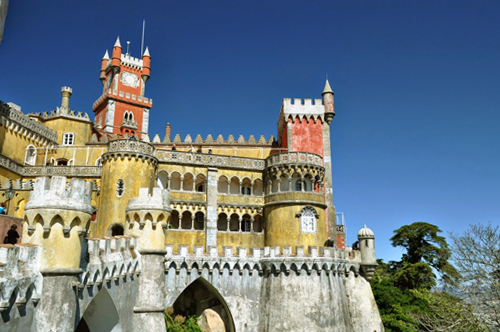
Photo by Camille Loiseau
Cultural Landscape of Sintra
In the 19th century Sintra became the first centre of European Romantic architecture. Ferdinand II turned a ruined monastery into a castle where this new sensitivity was displayed in the use of Gothic, Egyptian, Moorish and Renaissance elements and in the creation of a park blending local and exotic species of trees. Other fine dwellings, built along the same lines in the surrounding serra , created a unique combination of parks and gardens which influenced the development of landscape architecture throughout Europe.
Garrison Border Town of Elvas and its Fortifications
The site, extensively fortified from the 17th to 19th centuries, represents the largest bulwarked dry-ditch system in the world. Within its walls, the town contains barracks and other military buildings as well as churches and monasteries. While Elvas contains remains dating back to the 10th century ad, its fortification began when Portugal regained independence in 1640. The fortifications designed by Dutch Jesuit padre Cosmander represent the best surviving example of the Dutch school of fortifications anywhere. The site also contains the Amoreira aqueduct, built to enable the stronghold to withstand lengthy sieges.
Historic Centre of Évora
This museum-city, whose roots go back to Roman times, reached its golden age in the 15th century, when it became the residence of the Portuguese kings. Its unique quality stems from the whitewashed houses decorated with azulejos and wrought-iron balconies dating from the 16th to the 18th century. Its monuments had a profound influence on Portuguese architecture in Brazil.
Historic Centre of Guimarães
The historic town of Guimarães is associated with the emergence of the Portuguese national identity in the 12th century. An exceptionally well-preserved and authentic example of the evolution of a medieval settlement into a modern town, its rich building typology exemplifies the specific development of Portuguese architecture from the 15th to 19th century through the consistent use of traditional building materials and techniques.
Historic Centre of Oporto, Luiz I Bridge and Monastery of Serra do Pilar
The city of Oporto, built along the hillsides overlooking the mouth of the Douro river, is an outstanding urban landscape with a 2,000-year history. Its continuous growth, linked to the sea (the Romans gave it the name Portus, or port), can be seen in the many and varied monuments, from the cathedral with its Romanesque choir, to the neoclassical Stock Exchange and the typically Portuguese Manueline-style Church of Santa Clara.
Landscape of the Pico Island Vineyard Culture
The 987-ha site on the volcanic island of Pico, the second largest in the Azores archipelago, consists of a remarkable pattern of spaced-out, long linear walls running inland from, and parallel to, the rocky shore. The walls were built to protect the thousands of small, contiguous, rectangular plots (currais) from wind and seawater. Evidence of this viniculture, whose origins date back to the 15th century, is manifest in the extraordinary assembly of the fields, in houses and early 19th-century manor houses, in wine-cellars, churches and ports. The extraordinarily beautiful man-made landscape of the site is the best remaining area of a once much more widespread practice.
Monastery of Alcobaça
The Monastery of Santa Maria d'Alcobaça, north of Lisbon, was founded in the 12th century by King Alfonso I. Its size, the purity of its architectural style, the beauty of the materials and the care with which it was built make this a masterpiece of Cistercian Gothic art.
Monastery of Batalha
The Monastery of the Dominicans of Batalha was built to commemorate the victory of the Portuguese over the Castilians at the battle of Aljubarrota in 1385. It was to be the Portuguese monarchy's main building project for the next two centuries. Here a highly original, national Gothic style evolved, profoundly influenced by Manueline art, as demonstrated by its masterpiece, the Royal Cloister.
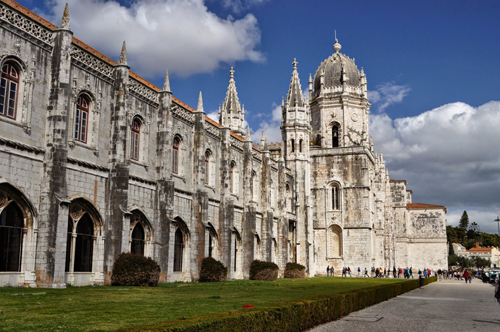
Photo by Camille Loiseau
Monastery of the Hieronymites and Tower of Belém in Lisbon
Standing at the entrance to Lisbon harbour, the Monastery of the Hieronymites – construction of which began in 1502 – exemplifies Portuguese art at its best. The nearby Tower of Belém, built to commemorate Vasco da Gama's expedition, is a reminder of the great maritime discoveries that laid the foundations of the modern world.
Prehistoric Rock Art Sites in the Côa Valley and Siega Verde
The two Prehistoric Rock Art Sites in the Côa Valley (Portugal) and Siega Verde (Spain) are located on the banks of the rivers Agueda and Côa, tributaries of the river Douro, documenting continuous human occupation from the end of the Paleolithic Age. Hundreds of panels with thousands of animal figures (5,000 in Foz Côa and around 440 in Siega Verde) were carved over several millennia, representing the most remarkable open-air ensemble of Paleolithic art on the Iberian Peninsula.
Côa Valley and Siega Verde provide the best illustration of the iconographic themes and organization of Paleolithic rock art, using the same modes of expression in caves and in the open air, thus contributing to a greater understanding of this artistic phenomenon. Together they form a unique site of the prehistoric era, rich in material evidence of Upper Paleolithic occupation.
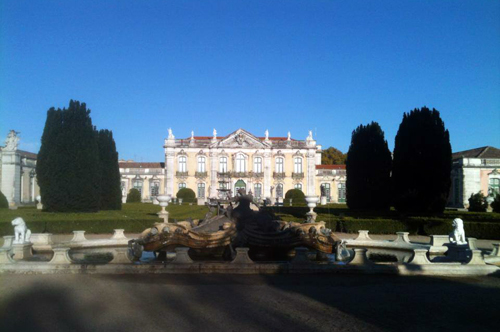
Royal Building of Mafra – Palace, Basilica, Convent, Cerco Garden and Hunting Park (Tapada)
Located 30 km northwest of Lisbon, the property was conceived by King João V in 1711 as a tangible representation of his conception of the monarchy and the State. This imposing quadrangular building houses the king’s and queen's palaces, the royal chapel, shaped like a Roman baroque basilica, a Franciscan monastery and a library containing 36,000 volumes. The complex is completed by the Cerco garden, with its geometric layout, and the royal hunting park (Tapada). The Royal Mafra Building is one of the most remarkable works undertaken by King João V, which illustrates the power and reach of the Portuguese Empire. João V adopted Roman and Italian baroque architectural and artistic models and commissioned works of art that make Mafra an exceptional example of Italian Baroque.
Sanctuary of Bom Jesus do Monte in Braga
Located on the slopes of Mount Espinho, overlooking the city of Braga in the north of Portugal, this cultural landscape evokes Christian Jerusalem, recreating a sacred mount crowned with a church. The sanctuary was developed over a period of more than 600 years, primarily in a Baroque style, and illustrates a European tradition of creating Sacri Monti (sacred mountains), promoted by the Catholic Church at the Council of Trent in the 16th century, in reaction to the Protestant Reformation. The Bom Jesus ensemble is centred on a Via Crucis that leads up the western slope of the mount. It includes a series of chapels that house sculptures evoking the Passion of Christ, as well as fountains, allegorical sculptures and formal gardens. The Via Crucis culminates at the church, which was built between 1784 and 1811. The granite buildings have whitewashed plaster façades, framed by exposed stonework. The celebrated Stairway of the Five Senses, with its walls, steps, fountains, statues and other ornamental elements, is the most emblematic Baroque work within the property. They are framed by lush woodland and embraced by a picturesque park that, masterfully set on the rugged hill, highly contributes to the landscape value of the ensemble.
University of Coimbra – Alta and Sofia
Situated on a hill overlooking the city, the University of Coimbra with its colleges grew and evolved over more than seven centuries within the old town. Notable university buildings include the 12th century Cathedral of Santa Cruz and a number of 16th century colleges, the Royal Palace of Alcáçova, which has housed the University since 1537, the Joanine Library with its rich baroque decor, the 18th century Botanical Garden and University Press, as well as the large “University City” created during the 1940s. The University’s edifices became a reference in the development of other institutions of higher education in the Portuguese-speaking world where it also exerted a major influence on learning and literature. Coimbra offers an outstanding example of an integrated university city with a specific urban typology as well as its own ceremonial and cultural traditions that have been kept alive through the ages.
Laurisilva of Madeira
The Laurisilva of Madeira is an outstanding relict of a previously widespread laurel forest type. It is the largest surviving area of laurel forest and is believed to be 90% primary forest. It contains a unique suite of plants and animals, including many endemic species such as the Madeiran long-toed pigeon.
Source: https://whc.unesco.org/en/statesparties/pt
|
|

|
|
|
|